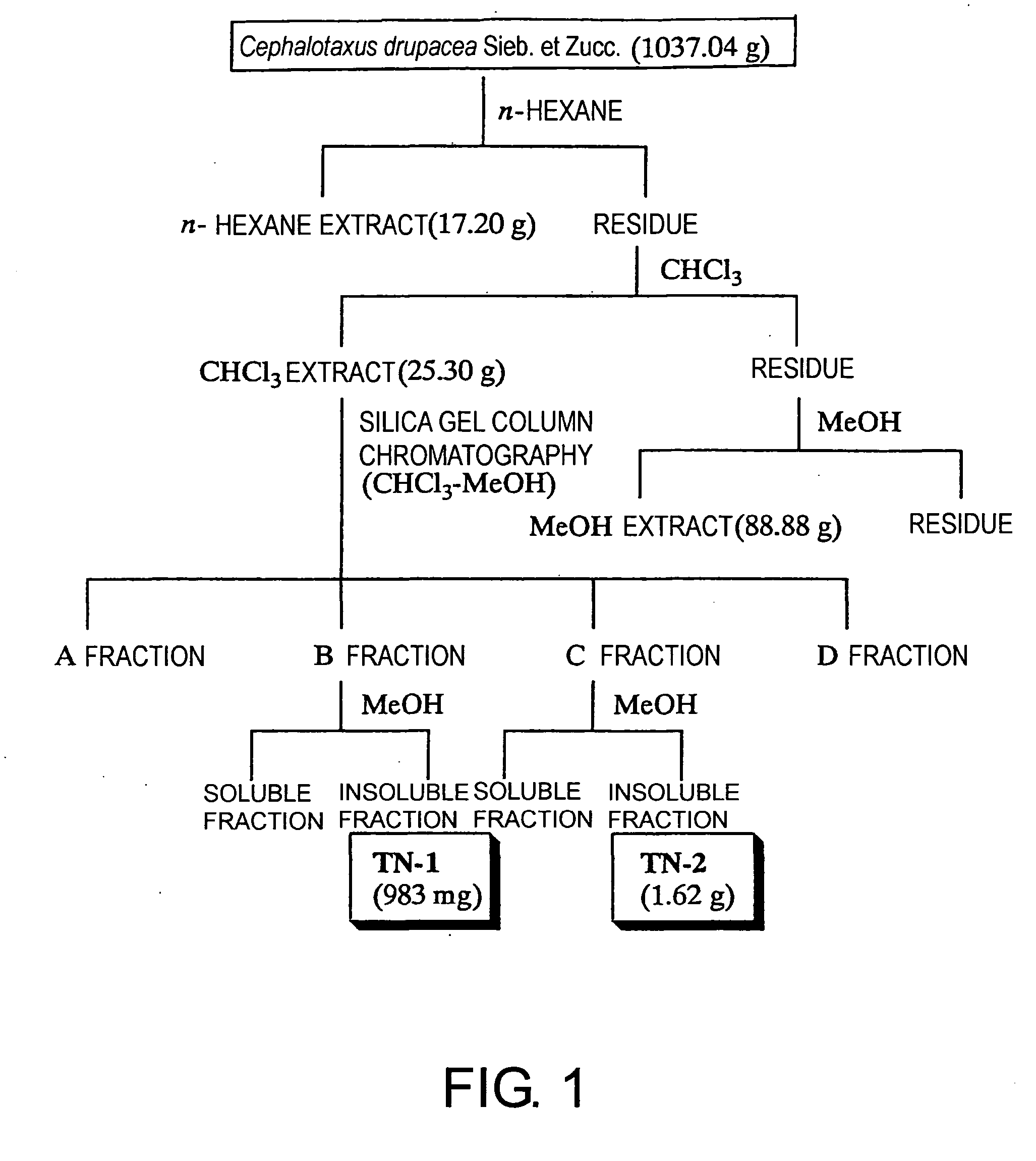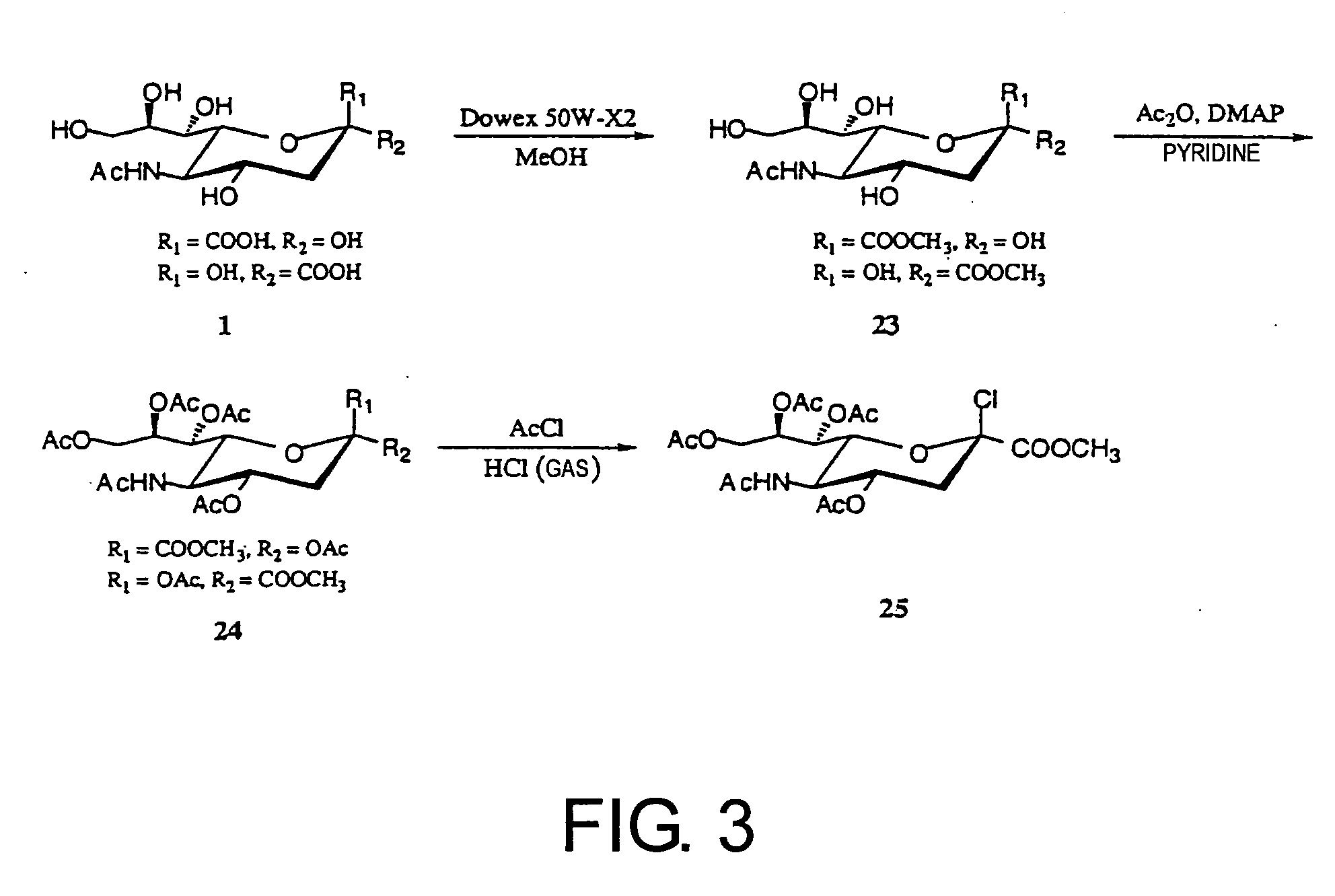Anti-influenza virus compound comprising biflavonoid-sialic acid glycoside
a technology of sialic acid glycoside and biflavonoid, which is applied in the field of antiviral compounds having sialidase inhibitory activities, can solve the problems of low bioavailability of anti-influenza countermeasures, serious life-threatening infectious diseases, and socially important challenges
- Summary
- Abstract
- Description
- Claims
- Application Information
AI Technical Summary
Benefits of technology
Problems solved by technology
Method used
Image
Examples
example 1
Separation and Purification of Biflavonoid Components
[0208] 1037.04 g of Cephalotaxus drupacea Sieb. et Zucc. (Cephalotaxaceae) leaves, which had been left in a room until dry, was twice extracted using n-hexane, CHCl3, and MeOH, in that order, each at room temperature and around the clock; the CHCl3 extract was separated according to the procedure in FIG. 1. As a result, 983 mg and 1.62 g of two compounds, tentatively named TN-1 and TN-2, were respectively isolated and then identified as amentoflavone 7,4′,7″-tri-O-methyl ether (19) and ginkgetin (20), respectively. Ginkgetin (20) can be prepared from Ginkgo biloba L. (Ginkgoaceae), Cephalotaxus koreana, Cephalotaxus griffithii, Cephalotaxus harringtonia C. koch (Cephalotaxaceae, heretofore), Taxus caspidata Sieb. et Zucc., Taxus caspidata Sieb. et Zucc. var. nana Rehder, Taxus baccata, Torreya nucifera Sieb. et Zucc. (Taxaceae, heretofore), Lonicera japonica (Caprifoliaceae), Podocarpus macrophylla (Podocarpaceae), Selaginella mo...
example 2
Synthesis of Sialyl Biflavonoids
1. Synthesis of Sugar Donor (2β-chloride) (25) (FIG. 3)
[0215] 200 ml of MeOH (dried) was added to sialic acid (N-acetylneuraminic acid) (1) (5.0 g, 16 mmol, provided by Kitasato University, School of Pharmaceutical Sciences) and stirred for one hour. To this solution, a molecular sieve (30.0 g) and Dowex 50W-X2 (Dow Chemical Co., 100-200 mesh) were added and the mixture was stirred for 24 hours at room temperature in air. After the reaction was completed, the molecular sieve and Dowex 50W-X2 were removed by centrifugation and filtration, followed by concentrating in vacuo to remove the solvent, yielding 1-methyl-N-acetylneuraminic acid (23) (4.80 g, 92%). (The term “compound (23)” may be simply expressed as “23” hereinafter. The same is true for other compounds hereinafter.)
[0216] 23 (4.80 g) thus obtained was dissolved in 150 ml pyridine (dried), and 120 ml of acetic anhydride (1.27 mol), and 4-dimethylaminopyridine (DMAP) (18-36 mg, 0.149-0.298 ...
example 3
Inhibitory Activity Against the Influenza Virus Sialidase
[0252] The four biflavonoids (19, 20, 21, and 22) isolated from plants, and the 19 biflavonoid-sialic acid conjugates prepared by organic synthesis [Gin-Neu-1-(R) (34a), Gin-Neu-2-(S) (35a), Gin-Neu-1-(S) (34b), Gin-Neu-2-(R) (35b), Gin-NeuAc-1 (30a), Gin-NeuAc-2 (31a), Gin-NeuAc-3 (30b), Gin-NeuAc-4 (31b), Gin-NeuAc-di(Mix) (mixture of 31a and 31b), TN1-Neu-1 (33a), TN1-Neu-2 (33b), TN1-Neu-Mix (mixture of 33a and 33b), TN-1-NeuAc-1 (29a), TN-1-NeuAc-2 (29b), Sci-Neu-1 (36a), Sci-Neu-2 (36b), Sci-Neu(Mix) (mixture of 36a and 36b), Sci-NeuAc-1 (32a), and Sci-NeuAc-2 (32b)] were measured for their inhibitory activities against the sialidases of influenza viruses A / PR / 8 / 34 (H1N1 subtype), A / Guizhou / 54 / 89 (H3N2 subtype), and B / Ibaraki / 2 / 85, at a final concentrations of 0.2 μg / mL, 1 μg / mL, 10 μg / μL, or 100 μg / mL, using 4-MU-NeuAc as a substrate and influenza HA vaccines as enzymes under each of the optimal pH conditions.
[0253] R...
PUM
 Login to View More
Login to View More Abstract
Description
Claims
Application Information
 Login to View More
Login to View More - R&D
- Intellectual Property
- Life Sciences
- Materials
- Tech Scout
- Unparalleled Data Quality
- Higher Quality Content
- 60% Fewer Hallucinations
Browse by: Latest US Patents, China's latest patents, Technical Efficacy Thesaurus, Application Domain, Technology Topic, Popular Technical Reports.
© 2025 PatSnap. All rights reserved.Legal|Privacy policy|Modern Slavery Act Transparency Statement|Sitemap|About US| Contact US: help@patsnap.com



